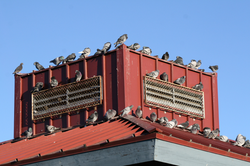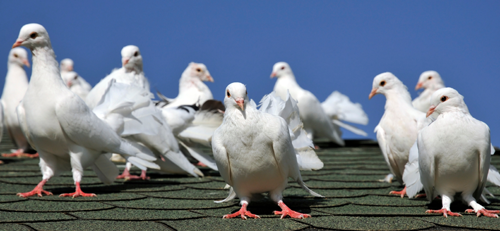Launceston is a city just north of the state of Tasmania, Australia, at the juncture of the North Esk, South Esk, and Tamar rivers. It is the second largest city in Tasmania with a population of over 100,000 people. The city recently sought advice on how to get rid of pigeons. A recent pigeon plague across inner Launceston rooftops created a smelly mess, cost local businesses thousands and threatened to potentially spread serious diseases.
The pigeons made their nests in some of the city's landmark buildings, including the old gasworks, the Telstra tower, and several of the city's historic banks and government institutions.
Some referred to the putrid pigeon infestation as a major nuisance and potentially toxic. The problem got so bad that one office was forced to close while hundreds of pigeons and their chicks were destroyed as the building's roof cavity was cleared and cleaned. Clearly, something had to be done to get rid of the pigeons.
Business owners noted that the pigeon problem was worse than dealing with rats. People were warned not to feed the pigeons to reduce the amount of droppings, which not only carry disease like salmonellosis, aspergillosis and histoplasmosis, but can create dangerous slip-and-fall liability for a business.
Commercial property owners demanded the problem be addressed. Some businesses had to move into temporary alternative workplaces in remote locales. Other building owners spent thousands removing the pests. The roof of a former bank drew hundreds of pigeons. The bird droppings were knee deep and had to be pumped into a waste disposal truck. To get rid of pigeons, they had to cast a bird net over the entire roof and put up bird spikes.
Bird netting works well to get rid of pigeons. For pigeons, a 1-1/8-inch mesh size is ideal.
When installing netting on rooftops or other outdoor areas, U.V. stabilized, flame resistant and rot- and water-proof netting is best. One brand of bird proof netting currently being marketing is said to be able to withstand severe temperature extremes--from 250-degree Fahrenheit to "sub-zero" temperatures. Non-conductive netting is ideal for installations where electrical conductivity or radio frequency interference could cause problems.
Another way to get rid of pigeons is to use bird spikes. These come in either rigid U.V.-resistant unbreakable polycarbonate or high strength, durable stainless steel. The spikes look threatening, but they won't harm birds or people. They have even been approved by a number of humane groups worldwide--including the U.S. Humane Society and PICAS (Pigeon Control Advisory Service). Bird spikes are available in various sizes and colors. Thee stainless steel spikes come in 3-, 5- and 8-inch widths; their plastic counterparts come in 3-, 5- and 7-inch widths. The plastic spikes are more economical, and they can be used near RF transmission equipment like cell phone antennas because they won't interfere with radiated energy. Bird spikes even come in a variety of colors--like white, tan, gray, black, brown, brick red and crystal clear.
2 Comments
There are about 146,000 retail gas stations and convenience stores in the United States. That's the good news for late-night shoppers and folks running out of gas. The bad news is, many of these stores lack effective pigeon control, which means feral pigeons can pretty much do what they please.  By Alex A. Kecskes
If you own a commercial building, you no doubt have had problems with pigeons. In most cases, the larger the building, the bigger the problem. For strip malls, commercial centers, warehouses and other large structures, pigeons can cause all sorts of headaches for property managers and property owners. If your building has a flat roof, pigeon debris, feathers and droppings can damage AC units, ventilators and drainage areas. Pigeons love to gather around rooftop equipment, and as you know, AC units are not cheap. They cost plenty to maintain and repair. Without proper pigeon control, pigeon debris can stop up rain vents and gutters, causing flooding. Hundreds or even thousands of gallons of water trapped on a long flat roof can lead to structural problems and ultimately roof collapse. Once this occurs, you have a huge problem in terms of damage to inventory inside a building. Whether your building is covered by a roof made of wood shingles or tiles, pigeons waste can be highly destructive. The acidic content of pigeon droppings can eat into the sub-roofing materials and eventually cause leaks. Bird droppings can also deface and damage your expensive signage—whether your signs are fabricated of metal, wood or plastic. Pigeons can also create an image problem. Bird droppings on entryways, walkways, display windows, benches, umbrellas and nearby lampposts can be a real turn off (and costly daily cleanups for you). |


 RSS Feed
RSS Feed